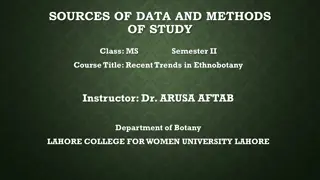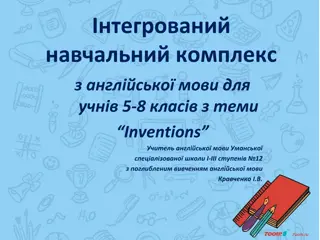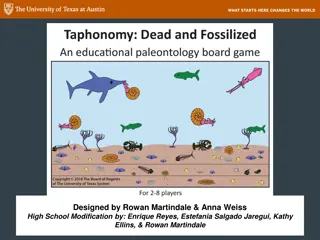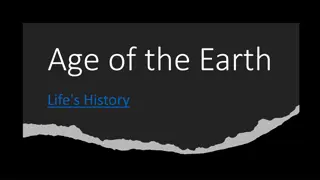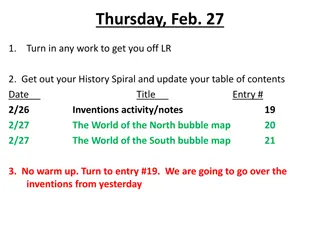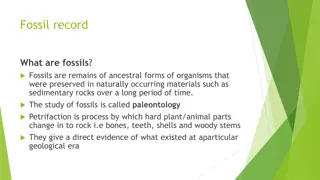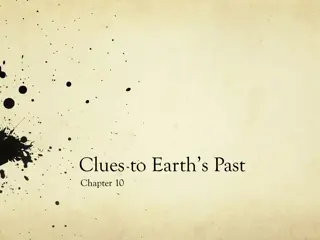Exploring Evolution and History: Fossils, Inventors, and More
Delve into the fascinating world of evolution, history, and inventions with a diverse range of topics covered, from fossil findings to the innovative creations of inventors like Garrett Augustus Morgan. Discover intriguing details about ancient species, geological formations, and remarkable individuals that have shaped our past.
Download Presentation

Please find below an Image/Link to download the presentation.
The content on the website is provided AS IS for your information and personal use only. It may not be sold, licensed, or shared on other websites without obtaining consent from the author. Download presentation by click this link. If you encounter any issues during the download, it is possible that the publisher has removed the file from their server.
E N D
Presentation Transcript
Evolution Groundhog Day
Do Now 1. Where am I likely to find a fossil of a Platyceras? 2. When did the Coelophysis exist?
About 220 220 mya or Triassic
Who is this? Garrett Augustus Morgan Many of the world s most famous inventors only produced one major invention that garnered recognition and cemented their prominent status, but one the country s most successful African- American inventors, created two the gas mask and the three- position traffic signal.
Index Fossils In the Time Distribution of Fossils column each of these letters is embedded in a vertical stripe. The stripe the letter is in tells us the group of organisms the fossil belonged to. The stripe goes through every period that the group lived during. The letter itself is found in only one period. This is the only period during which that particular fossil lived.
The Soap Lady is the name given to a woman whose body was exhumed in Philadelphia in 1875. The specimen is unique because a fatty substance called adipocere encases the remains. Adipocere formation is not common, but it may form in alkaline, warm, airless environments, such as the one in which the Soap Lady was buried.
Using Fossils The study of the fossil record has provided important information for at least four different purposes. The progressive changes observed within an animal group are used to describe the evolution of that group.
Evolution of Life The Earth s original atmosphere was made up of gases similar to those released in volcanic eruptions Water Vapor Carbon Dioxide Nitrogen As primitive organisms evolved, they used photosynthesis and released oxygen.
Fossils indicate that animals become more advanced as time goes on One celled organisms Multicelled soft body organisms Multicelled hard body organisms Cambrian Period
Fossils are useful in the exploration for minerals and mineral fuels. For example, they serve to indicate the stratigraphic position of coal seams.
Charles Darwin Provided scientific evidence that all species of life have evolved over time from one or a few common ancestors through the process of Natural Selection
The basic idea of biological evolution is that populations and species of organisms change over time. Darwin also suggested a mechanism for evolution: natural selection, in which heritable traits that help organisms survive and reproduce become more common in a population over time
Theory of Natural Selection unfavorable traits become less common because they die off favorable traits become more common because they can reproduce
Fossil Evidence of Evolution Fossils show how small adaptations began to change species.
Problems with Darwin No mechanism Darwin has no explanation on how variations are passed on Mendel
Groups of chimpanzees within central Africa are more different genetically than humans living on different continents,
Once in our history, the world-wide population of human beings skidded so sharply we were down to roughly a thousand reproductive adults. One study says we hit as low as 40. More likely there was a drastic dip and then 5,000 to 10,000 bedraggled Homo sapiens struggled together in pitiful little clumps hunting and gathering for thousands of years until, in the late Stone Age, we humans began to recover.
Around 70,000 B.C., a volcano called Toba, on Sumatra, in Indonesia went off, blowing roughly 650 miles of vaporized rock into the air. It is the largest volcanic eruption we know of, dwarfing everything else.. With so much ash, dust and vapor in the air Toba "dimmed the sun for six years, disrupted seasonal rains, choked off streams and scattered whole cubic miles of hot ash (imagine wading through a giant ashtray) across acres and acres of plants." Berries, fruits, trees, African game became scarce;
Fifty-thousand years ago, humans romantic horizons extended far beyond other boring Homo sapiens. That s according to a July 2019 study that describes how our ancestors often mated with other species of the Homo genus: Neanderthals, Denisovans, and two other unnamed hominids.
The boy had fallen, running home after school, and skinned his left knee. It was no more than a scratch. His trousers were not even torn, but by night the knee had begun to ache. Nothing much, he thought, being 13 and the sturdy son of a frontiersman. Ignoring the pain, he climbed into bed
But by the time dinner was ready, the boy had climbed into bed. The shoe had to be cut off his swollen and discolored leg. Why on earth didn t you tell somebody? asked his mother. Go quick, she called to his father, and fetch the doctor. Old Dr. Conklin examined the leg and shook his head. It s not likely we can save it! It means, explained the doctor gently, if things get worse we ll have to cut off your leg.
From the movie "Glory" Pvt Trip Col. Robert Shaw
Sgt. William Harvey Carney Sgt. William Harvey Carney Col. Robert Shaw Col. Robert Shaw
William Harvey Carney (February 29, 1840 December 9, 1908) was an American soldier during the American Civil War. Born as a slave, he was awarded the Medal of Honor in 1900 for his gallantry in saving the regimental colors (American flag) during the Battle of Fort Wagner in 1863.
Fossils provide the geologist a quick and easy way of assigning a relative age to the strata in which they occur. Fossils used to identify geologic relationships are known as index fossils. Fossil organisms may provide information about the climate and environment of the site where they were deposited and preserved Certain species of coral require warm, shallow water, or certain forms of deciduous angiosperms can only grow in colder climatic conditions









